
U.S. Shutdown & Global Market Outlook – Week 42, 2025
- U.S. Economic Review – Resilient Consumption, Sticky Inflation, and Fiscal Crosswinds
- U.S. Economic Outlook | Week 42, 2025 (October 13–19)
- United Kingdom – Weekly Economic Review & Outlook
- GBP/USD — Weekly Outlook & Technical Levels
- Energy Market Weekly Review & Outlook
- Summary
- Gold — Current Market Conditions & Weekly Outlook
- Crypto Market Conditions & Bitcoin (BTC) Weekly Outlook
- Bitcoin (BTC) Fundamental Outlook
Markets begin the week cautiously optimistic as the U.S. government shutdown curtails economic data releases, leaving traders reliant on qualitative cues like the Fed’s Beige Book and housing sentiment reports. Real yields remain elevated, the U.S. dollar firm, and liquidity thin. Equities pivot toward earnings quality, while commodities stay range-bound—oil supported by OPEC+ discipline and gold steady on safe-haven demand.
In Europe and the UK, growth is soft and inflation sticky, keeping central banks cautious. China’s policy tone and Japan’s yen moves steer Asian flows. Cross-asset tone: USD firm, equities selective, bonds volatile, oil stable, gold constructive.
U.S. Economic Review – Resilient Consumption, Sticky Inflation, and Fiscal Crosswinds
The U.S. economy continues to show cautious stability as the fourth quarter begins, balancing resilient consumer spending and a solid labor market against persistent inflation and fiscal stress. The ongoing government shutdown has disrupted several key data releases, including trade, inventories, and jobless claims, leaving markets with limited clarity. However, the Bureau of Labor Statistics confirmed that September CPI will still be released on October 24, just ahead of the FOMC’s October 28–29 meeting.
At its September meeting, the Federal Reserve lowered rates by 25 bps to 4.00%–4.25%, citing labor risks, though minutes signaled a mildly hawkish tone. Policymakers warned that inflation risks remain tilted upward, and economic forecast headline CPI at 3.1% YoY for September, marking a fourth straight year above the Fed’s target.
Consumer confidence held steady, with the University of Michigan index at 55.0, and inflation expectations stable—1-year at 4.6%, 5-year at 3.7%. Households remain cautious amid high living costs and political uncertainty. Meanwhile, the Fed’s balance sheet rose slightly to $6.59 trillion, indicating sufficient liquidity despite ongoing quantitative tightening.
Energy data show mild tightening—crude stocks up 3.7M barrels, gasoline down 1.6M, and rig counts at 418, signaling producer caution rather than collapsing demand. Bond yields climbed to multi-month highs (10Y at 4.12%, 30Y at 4.73%) amid growing concerns about debt sustainability and fiscal gridlock, tightening financial conditions even without new Fed action.
Despite missing job data, the labor market remains gradually cooling but resilient, with steady wage growth supporting consumption. The U.S. Dollar Index strengthened modestly on safe-haven flows. Economician expects one rate cut in 2025 and two in early 2026, bringing policy toward a neutral 3.00%–3.25%.
U.S. Economic Outlook | Week 42, 2025 (October 13–19)
The U.S. economy enters mid-October facing another data-light week as the federal government shutdown continues, disrupting key releases and leaving markets to rely on private and regional indicators. With most Bureau of Labor Statistics (BLS) data paused, the only confirmed report is the September CPI, rescheduled for October 24—just ahead of the FOMC meeting on October 28–29. This data vacuum has heightened uncertainty, keeping investors focused on Federal Reserve commentary and corporate earnings for direction.
The week opens quietly on Monday, October 13, with Columbus Day / Indigenous Peoples’ Day, when most government offices and banks will close. On Tuesday, attention turns to the NFIB Small Business Optimism Index, one of the few releases unaffected by the shutdown. The report is expected to offer valuable insights into business sentiment, hiring intentions, and price expectations—critical gauges of underlying inflation pressure and employment trends.
By Wednesday, focus shifts to the New York Fed’s Empire State Manufacturing Survey, which should provide early signals on new orders, output, and prices. Later that day, the Fed’s Beige Book—a collection of anecdotal evidence from its 12 districts—will take center stage. In the absence of hard data, its tone on wages, consumer demand, and credit conditions will be key in shaping market expectations heading into the next FOMC meeting.
On Thursday, the spotlight moves to private-sector indicators, as major federal reports such as PPI and Retail Sales remain delayed. Traders will monitor the Philadelphia Fed Manufacturing Index and the NAHB Housing Market Index, the latter expected to stay weak around the low-30s due to high mortgage rates and affordability challenges. Any improvement would hint at early signs of stabilization in housing.
Friday’s schedule was supposed to feature Housing Starts, Building Permits, and Industrial Production, but most will likely be postponed. If the Fed manages to release industrial output data, expectations are for a flat September reading, following a modest 0.1% gain in August, as strength in tech and aerospace offsets weaker investment elsewhere.
Consumers remain the backbone of growth, with August retail sales surprising to the upside and September likely posting another 0.4% increase. However, momentum is softening amid slower wage gains, tariff pass-throughs, and inflation fatigue.
Overall, the U.S. economy continues to navigate a fragile soft landing—growth is slowing but steady, inflation remains elevated yet contained, and the Fed’s patient stance is keeping financial conditions tight. Markets are expected to remain cautious, with the U.S. dollar firm, yields high, and equities consolidating ahead of the pivotal CPI release on October 24.
USD & Wall Street – Weekly Outlook (Week 42, 2025)
The U.S. trading week opens under quiet conditions as the ongoing federal government shutdown continues to delay major data releases, leaving investors with limited visibility on the economy. With hard data scarce, attention turns to a few key events — the Federal Reserve’s Beige Book, NAHB Housing Market Index, and the first major wave of Q3 earnings, which together will help shape sentiment ahead of the October 28–29 FOMC meeting.
Macro Setup
With most federal agencies offline, markets will closely analyze the Beige Book on Wednesday for clues about demand, wages, and pricing pressures. On Thursday, the NAHB Home Builders Index will offer one of the few real-time snapshots of the housing market, which remains sensitive to elevated mortgage rates. Meanwhile, earnings season accelerates, led by major banks and financials. Their results will provide insight into credit demand, margin resilience, and consumer health, setting the tone for broader equity performance.
U.S. Dollar (DXY)
The dollar maintains a neutral-to-firm bias, supported by high Treasury yields and cautious positioning. In a low-data environment, the “good news = steady USD” dynamic remains dominant. The DXY stays constructive while above 98.00, with resistance near 99.80–100.90 and support at 97.00–96.50.
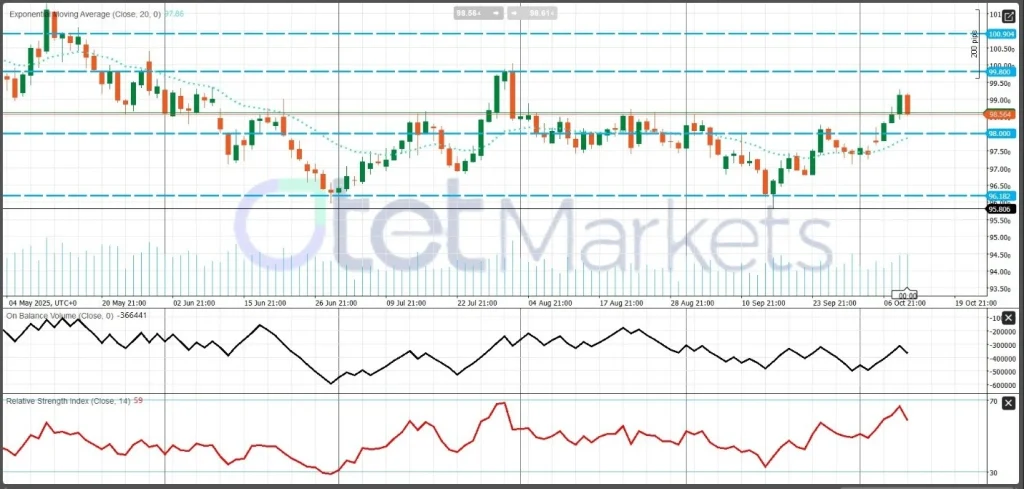
Wall Street (Nasdaq-100 / NDX)
Market sentiment remains fragile but resilient, as investors weigh earnings reports against political and policy uncertainty. Comments from former President Trump have stirred volatility, but tech and AI-linked sectors continue to guide momentum. Key support lies between 23,800–23,000, while resistance appears near 24,500–25,000.
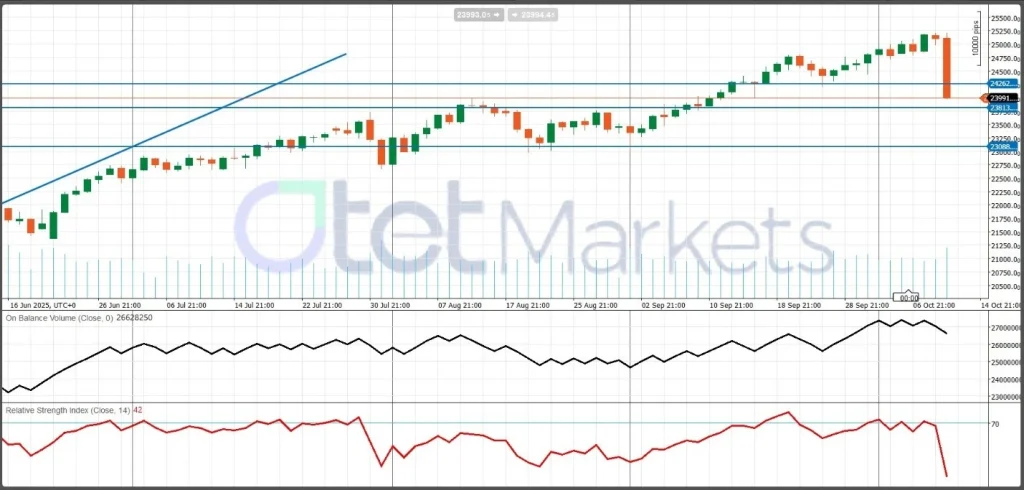
United Kingdom – Weekly Economic Review & Outlook
Overall, the UK remains stuck in a low-growth, high-cost cycle, with little sign of relief ahead. Fiscal uncertainty and cautious consumer behavior continue to weigh on sentiment, while the BoE’s prolonged tight stance keeps the recovery fragile and uneven.
Fragile Stability Amid Stagnation and High Costs
The UK economy closed the second week of October on a fragile but stable footing, with data underscoring weak consumer confidence, a struggling construction sector, and persistent cost pressures. Inflation expectations remain steady, but high borrowing costs and muted household activity continue to restrain growth, leaving the economy effectively stagnant as it heads into Q4.
Consumer Confidence & Domestic Demand
The Thomson Reuters/Ipsos PCSI fell to 48.3 in October from 49.9, sliding further below the neutral 50 mark and signaling renewed pessimism among consumers. High living costs, rising mortgage payments, and political uncertainty in Westminster continue to weigh on sentiment. Elevated Bank of England (BoE) rates are filtering deeper into housing and credit markets, tightening financial conditions. Discretionary spending remains weak, particularly in retail and services, limiting economic momentum.
Construction & Housing Weakness
The S&P Global Construction PMI stayed in contraction at 46.2, marking a fourth straight month below 50. Persistent cost pressures, high material prices, and subdued new orders are curbing activity, while developers remain reluctant to launch new projects amid weak demand and elevated rates.
In housing, the Halifax Price Index showed a 0.3% monthly fall in September, reversing August’s small gain. Annual price growth slowed to +1.3% YoY from +2.2%, confirming that affordability challenges persist despite mortgage rates easing slightly to 6.78%.
GDP & Labor Market Outlook
After showing resilience earlier in 2025, UK growth is losing momentum. GDP expanded 0.7% in Q1 and 0.3% in Q2, largely due to temporary boosts such as front-loaded spending and public demand. July’s GDP was flat, and sentimental data suggest further cooling ahead of the Autumn Budget. Economists forecast just 0.1% MoM growth for August, highlighting the economy’s fragile pace.
The focus now shifts to labor market data (Tuesday, Oct 14). Wage growth is expected to remain around 4.7% YoY, while unemployment could edge slightly higher. A surprise rise in wages may reignite inflation fears, whereas weaker earnings or higher joblessness could confirm that tight monetary policy is finally slowing hiring.
Policy & Market Outlook
With inflation still well above the 2% target, the BoE remains trapped between persistent price pressures and weak growth. Policymakers are expected to hold rates steady through year-end, maintaining a restrictive stance into early 2026.
Market implications
- GBP: Sensitive to wage surprises; stronger data could support the pound.
- Gilts: Softer labor data may ease yields slightly; strong wages could lift them.
- Equities: Defensive and export-oriented sectors likely to outperform; rate-sensitive industries to lag.
GBP/USD — Weekly Outlook & Technical Levels
The UK labor market and earnings data (Tuesday) will be the key domestic catalyst for the pound this week. A stronger wage print or a surprise drop in claimant counts would likely support GBP by reinforcing expectations of stickier inflation and a longer Bank of England (BoE) policy hold. Conversely, softer figures could weigh on the currency by signaling that restrictive policy is beginning to cool demand.
On the U.S. side, economic data remains limited amid the ongoing government shutdown. The Federal Reserve’s Beige Book (Wednesday) and several regional Fed surveys will shape the tone heading into the October 24 CPI release. Market positioning is already cautious, suggesting choppy, range-bound trade in the near term. If long-end U.S. Treasury yields remain elevated, the dollar’s bid tone should persist; however, any risk-on shift or lower yields could favor upside moves in GBP/USD.
Technical Overview (Daily / H4 Confluence)
Overall, GBP/USD remains technically pressured but fundamentally data-dependent this week. The labor market report will likely set the tone: stronger wage growth could spark a short-term recovery, while any signs of cooling may keep the pair under downward pressure. Until a sustained close above 1.34, the broader bias remains bearish within a softening macro backdrop.
Resistance (Sell / Confirmation Zones)
- 1.3400: Major psychological level and prior supply zone — likely to attract initial sellers.
- 1.3500–1.3615: Recent swing-high resistance and H4 supply area. A decisive break and hold above 1.3400 could shift short-term momentum to bullish.
- 1.3200: Prior weekly pivot and potential extension target if upside momentum strengthens.
Support (Buy / Defense Zones)
- 1.3300–1.3245: First near-term support band where dip-buying interest may reappear.
- 1.3100–1.3000: Key structural support area — a break below this zone would confirm trend continuation to the downside.
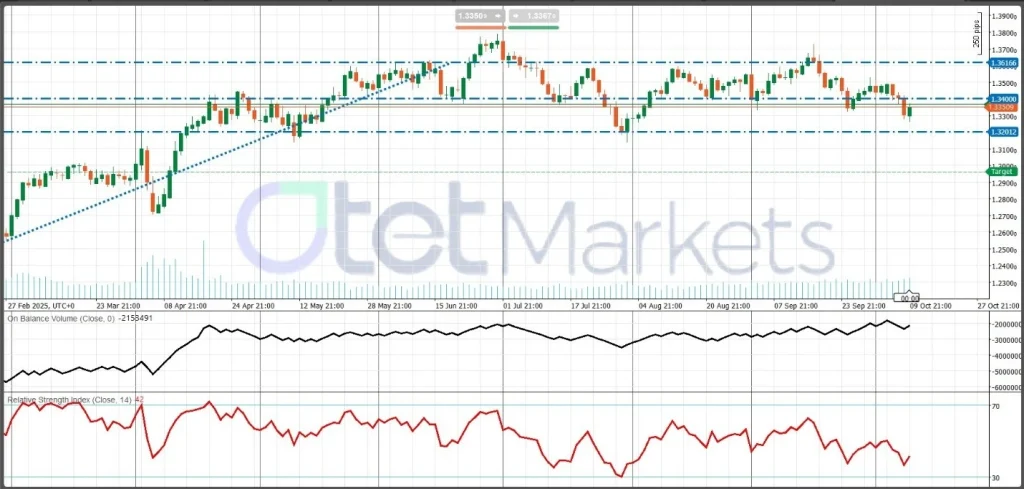
Energy Market Weekly Review & Outlook
The global energy market ended the week mixed but resilient, as both oil and natural gas prices dropped sharply in late trading amid rising inventories and renewed trade war tensions. While geopolitical uncertainty supported some safe-haven flows, demand signals from major economies — notably the U.S., China, and Japan — remained inconsistent.
Crude Oil: Range-Bound and Data-Driven
Oil prices remained range-bound, pressured by steady supply builds but cushioned by geopolitical and policy uncertainty. The U.S. Baker Hughes rig count fell to 418 (–3 w/w), marking a second consecutive decline, while total rigs dropped to 547, signaling continued capital discipline among producers.
Inventory data reinforced the mixed tone:
- API: +2.78M barrels
- EIA: +3.7M barrels
- Gasoline: –1.6M barrels
- Refinery utilization: +1.0% w/w
These figures suggest stable output but creeping stock levels, keeping the market balanced. Excluding trade tensions, sentiment leans neutral to mildly bullish, with falling rig activity providing a soft floor for prices. Still, global growth worries and trade frictions cap any significant upside momentum.
Outlook: If trade disputes persist, oil could face renewed selling pressure. A break below $60 WTI would confirm further downside, while any rebound above $61.20–$63 could trigger short-term consolidation.
Natural Gas: Inventories Build, Winter Nears
The EIA reported an 80B cubic feet build in U.S. gas storage, slightly above expectations (76B). Stocks remain comfortably above the five-year average, signaling ample pre-winter reserves. However, seasonal heating demand across Europe and Asia could tighten markets by November, especially if temperatures drop below normal or LNG demand rises.
Market View: Short-term oversupply keeps prices contained, but volatility could increase later in Q4 as winter-driven demand builds.
Macro & Geopolitical Landscape
Energy traders faced multiple crosscurrents:
- U.S. political gridlock and the ongoing shutdown weighed on sentiment.
- Japan’s leadership change under Sanae Takaichi lifted hopes for fiscal expansion and modestly improved oil demand expectations.
- Middle East tensions eased slightly amid Trump’s peace efforts, though Russia-Ukraine risks lingered.
Summary
This week’s developments highlight a stable yet cautious energy environment — solid fundamentals but fragile sentiment.
- Oil: Below $60; rigs down, inventories up.
- Gas: Storage builds continue; mild oversupply.
- Sentiment: Cautiously bearish for oil, constructive for gas ahead of winter.
Technical levels (WTI)
WTI crude has been in a gradual downtrend since early August. Recent shifts in market sentiment and economic uncertainty have reinforced downside momentum. Near term, a modest rebound may occur early next week, but the broader trend remains lower.
- Key support: $60 — holding this level keeps the bearish bias intact.
- Resistance: $61.20 — a breakout above could invite sideways consolidation in the $61–$63 range.
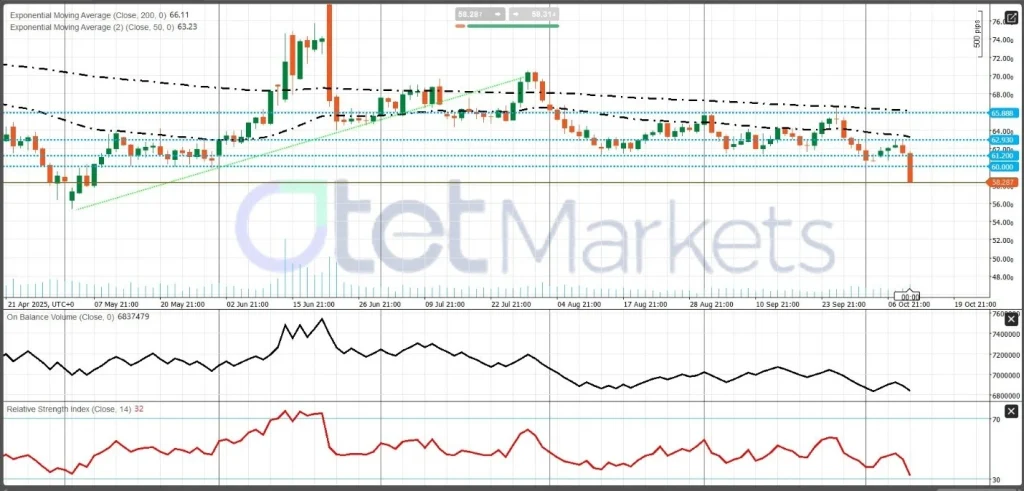
Gold — Current Market Conditions & Weekly Outlook
Gold remains well supported on dips, though upside momentum continues to face resistance. With a thin U.S. data calendar this week, price action is likely to stay highly sensitive to real-yield fluctuations, USD movements, and geopolitical headlines, as traders’ position ahead of the next major catalyst — the U.S. CPI release on Friday, October 24.
Current Market Landscape
Real 10-year yields remain elevated but slightly off their recent highs, keeping a lid on gold’s sustained rallies. The U.S. dollar is firm but range-bound, limiting impulsive upside but failing to fully suppress safe-haven demand.
ETF flows appear to have stabilized following a volatile summer marked by outflows, while physical premiums across Asia remain firm, reflecting steady seasonal buying. Markets continue to lean toward a patient Federal Reserve stance heading into year-end. If the Fed’s Beige Book (Wednesday) shows signs of cooling demand or wage pressures, it could soften real-rate expectations and support gold. Conversely, a hawkish tone could briefly cap prices.
On the geopolitical front, underlying risks remain elevated. Persistent tensions in the Middle East, ongoing Russia–Ukraine conflict, and U.S.–China trade frictions maintain a moderate risk premium in gold pricing. However, sharp headline-driven rallies tend to fade unless these risks lead to broader supply chain disruptions or growth concerns.
Overall, gold’s core bullish narrative — supported by portfolio hedging, sticky inflation, and geopolitical uncertainty — remains intact. Yet, meaningful upside still depends on a pullback in real yields or a pause in the U.S. dollar’s advance.
Week-Ahead Drivers
- Fed Beige Book (Wed): Key qualitative update on wages and demand. Softer tone = lower real-rate expectations = bullish for gold.
- NAHB Housing Index (Thu): Weak housing sentiment could indirectly pressure yields lower, lending mild support.
- Earnings Season: If corporate guidance turns cautious and equities lose momentum, defensive allocations may favor gold.
- USD & Yields: Daily direction remains dominated by DXY and real yields — gold typically softens on USD spikes and rebounds when yields ease.
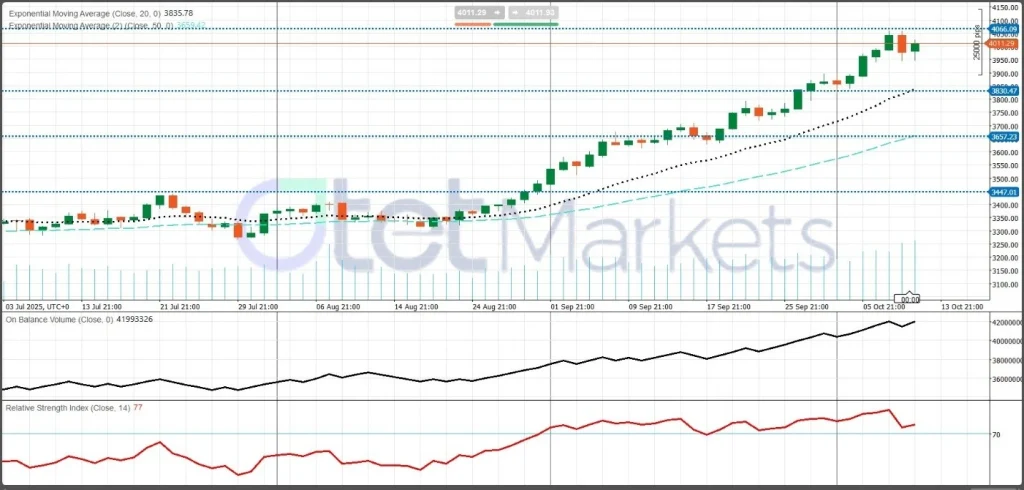
Technical Setup (XAU/USD)
Bias remains constructive while the market holds above key support.
- Resistance: $4,066 (all-time high)
- Support: $4,000 – $3,950 – $3,880
As long as gold holds above the $3,900 area, the medium-term outlook stays bullish, though momentum will likely remain choppy until U.S. inflation data offers a clearer signal.
Crypto Market Conditions & Bitcoin (BTC) Weekly Outlook
Crypto markets enter the new week in two-way mode — dip buyers remain active, but upside momentum is stalling amid a firm U.S. dollar and higher real yields. With the next major macro event — U.S. CPI on October 24 — still ahead, traders should expect range-bound price action with a slight downside bias, punctuated by headline-driven volatility.
Market Conditions (Cross-Crypto)
A data-light U.S. calendar keeps focus on the Federal Reserve’s Beige Book, yield moves, and the dollar’s tone. Historically, risk assets — crypto included — tend to chop sideways when macro visibility narrows.
Perpetual/futures funding rates remain stable to mildly positive, reflecting a modest long bias. However, open interest remains elevated relative to spot volumes, setting the stage for liquidation squeezes in either direction.
Liquidity has improved versus September, yet weekend and Asia sessions still carry higher volatility risk due to thinner order books. Large-caps — particularly Bitcoin (BTC) — continue to outperform mid- and small-cap tokens, while rotations across altcoins remain short-lived. For now, tactical trading at defined levels is outperforming broad directional bets — there’s no “alt season” in sight.
Bitcoin (BTC) Fundamental Outlook
BTC remains inversely correlated with real yields and the U.S. dollar. Any pullback in yields or a risk-on tone in equities tends to unlock upside moves. Spot demand remains healthy, supporting dips, but leveraged long positions near recent highs are vulnerable if the dollar strengthens further.
Key metrics to watch
- ETF net flows – signal institutional demand.
- Stablecoin issuance – proxy for market liquidity and risk appetite.
- Exchange reserves – gauge potential sell-side pressure.
A sustained pickup in spot-driven buying remains the cleaner confirmation for bullish continuation. Structurally, BTC’s higher timeframe trend stays intact, but range trading dominates this week.
Trading bias
- Buy dips into
- Breakout entries only above $122K (daily/H4 close)
- Turn defensive below $112.5K
As CPI nears, keep position sizes flexible — headline risks remain high.
BTC Technical Overview (Spot)
BTC remains constructive while holding above its rising daily base; momentum fades only if the mid-$110Ks are lost. Expect “range-then-break” behavior with potential fakeouts near major levels.
Resistance (Sell / Confirm Zones)
- $116.0K–$116.8K → Initial resistance / bounce zone
- $120.0K–$122.0K → Prior swing supply & psychological cap
- $124.5K → First measured extension target
- $128.0K–$130.0K → Higher-timeframe supply zone
Support (Buy / Defense Zones)
- $112.5K–$113.5K → 50-day average / short-term floor
- $108.0K–$109.0K → Strong demand area before trend fatigue
- $105.0K–$100.0K → Deep structural supports tested only on risk-off spikes
Crypto markets remain technically resilient but tactically fragile. Expect range-trading dominance until fresh macro signals arrive. BTC’s structural uptrend is intact, but sustained upside will require softer yields or a weaker dollar — otherwise, the market stays trapped in consolidation mode.
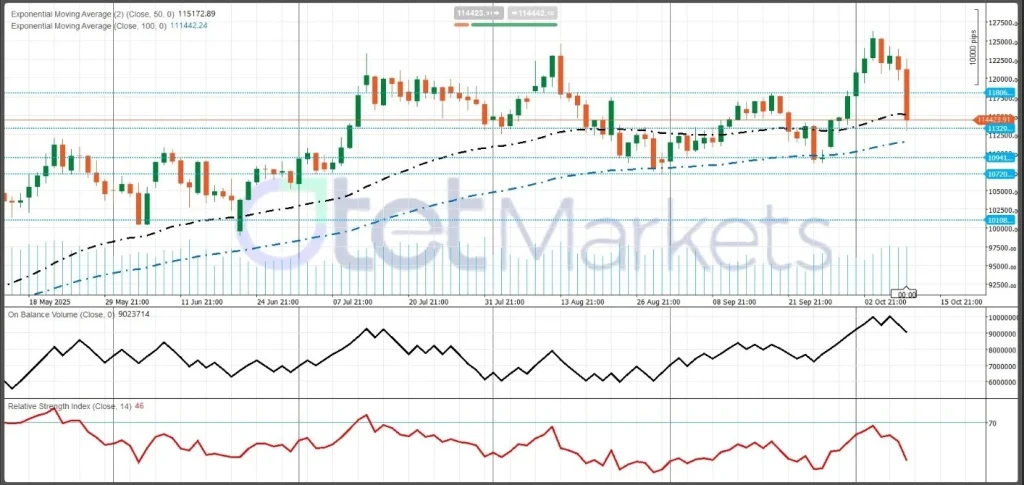
Share
Hot topics

Best Forex Trading Hours for Iranian Traders
The Forex market operates 24-hours a day, but clearly not every hour, equal it could even be every trading session, is profitable. There are times when the market sleeps, is...
Read more




Submit comment
Your email address will not be published. Required fields are marked *